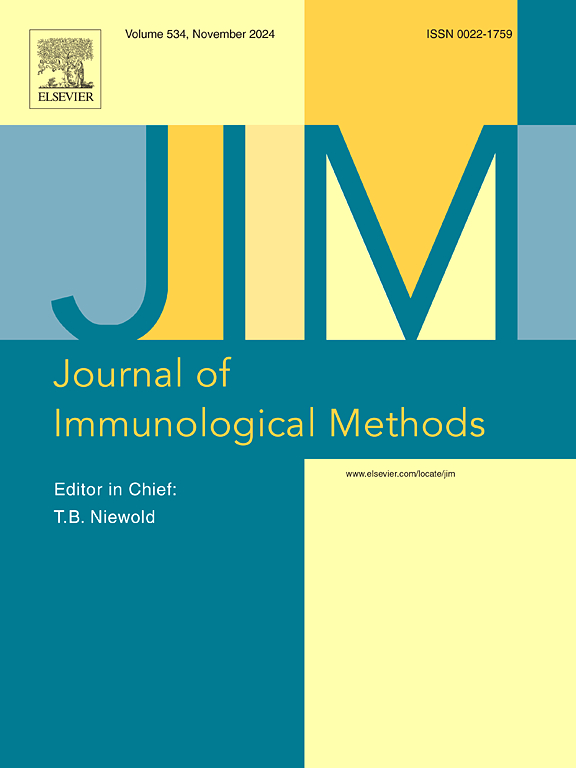肽原纤维作为疫苗:概念证明。
IF 1.6
4区 医学
Q4 BIOCHEMICAL RESEARCH METHODS
引用次数: 0
摘要
背景:快速开发疫苗平台对于应对流行病和埃博拉等新发传染病的大流行至关重要。本研究探索自组织成淀粉样原纤维的肽疫苗的潜力,旨在增强免疫原性,同时考虑安全性和交叉反应性。方法:我们合成了两个肽,G33和G31,对应于埃博拉病毒GP2蛋白的一个片段,其中G33已知形成淀粉样原纤维。用MTT法对MDCK和A549细胞培养物进行体外毒性评估。在体内研究中,用这些肽免疫balb/c小鼠。ELISA检测重组eGP蛋白特异性抗体的免疫原性。测定血液学参数,并记录安乐死后器官的组织病理学变化。结果:两种多肽在浓度为500 μg/ml时均无细胞毒性。g33免疫小鼠的抗体滴度高于G31免疫小鼠或对照组,血液学特征没有明显改变。然而,组织学分析显示门静脉周围浸润和淋巴-巨噬细胞聚集在肝脏和肾脏,提示免疫反应激活。G33肽与哺乳动物蛋白的同源性存在交叉反应的风险。结论:G33肽形成的淀粉样原纤维可引起更强的免疫应答,且无明显血液学变化,说明基于原纤维的肽疫苗是可行的。然而,在考虑临床应用之前,分子模拟引起自身免疫反应的可能性需要进一步研究。本文章由计算机程序翻译,如有差异,请以英文原文为准。
Peptide fibrils as a vaccine: Proof of concept
Background
Rapid vaccine platforms development is crucial for responding to epidemics and pandemics of emerging infectious diseases, such as Ebola. This study explores the potential of peptide vaccines that self-organize into amyloid-like fibrils, aiming to enhance immunogenicity while considering safety and cross-reactivity.
Methods
We synthesized two peptides, G33 and G31, corresponding to a segment of the Ebola virus GP2 protein, with G33 known to form amyloid-like fibrils. Their toxicity was assessed in vitro using an MTT assay on MDCK and A549 cell cultures. For in vivo studies, balb/c mice were immunized with these peptides. Immunogenicity was gauged by ELISA for specific antibodies against the recombinant eGP protein. Hematological parameters were determined, and histopathological changes in organs were documented post-euthanasia.
Results
Both peptides exhibited no cytotoxicity up to 500 μg/mL. G33-immunized mice developed higher antibody titers than those receiving G31 or control, without significant alterations in hematological profiles. However, histological analysis showed periportal infiltration and lymphoid-macrophage clusters in the liver and kidneys, suggesting immune response activation. The homology between the G33 peptide and mammalian proteins poses risks of cross-reactivity.
Conclusion
The amyloid-like fibrils formed by the G33 peptide elicited a stronger immune response without significant hematological changes, underlining the feasibility of fibril-based peptide vaccines. However, the potential for autoimmune responses due to molecular mimicry warrants further investigation before clinical applications can be considered.
求助全文
通过发布文献求助,成功后即可免费获取论文全文。
去求助
来源期刊
CiteScore
4.10
自引率
0.00%
发文量
120
审稿时长
3 months
期刊介绍:
The Journal of Immunological Methods is devoted to covering techniques for: (1) Quantitating and detecting antibodies and/or antigens. (2) Purifying immunoglobulins, lymphokines and other molecules of the immune system. (3) Isolating antigens and other substances important in immunological processes. (4) Labelling antigens and antibodies. (5) Localizing antigens and/or antibodies in tissues and cells. (6) Detecting, and fractionating immunocompetent cells. (7) Assaying for cellular immunity. (8) Documenting cell-cell interactions. (9) Initiating immunity and unresponsiveness. (10) Transplanting tissues. (11) Studying items closely related to immunity such as complement, reticuloendothelial system and others. (12) Molecular techniques for studying immune cells and their receptors. (13) Imaging of the immune system. (14) Methods for production or their fragments in eukaryotic and prokaryotic cells.
In addition the journal will publish articles on novel methods for analysing the organization, structure and expression of genes for immunologically important molecules such as immunoglobulins, T cell receptors and accessory molecules involved in antigen recognition, processing and presentation. Submitted full length manuscripts should describe new methods of broad applicability to immunology and not simply the application of an established method to a particular substance - although papers describing such applications may be considered for publication as a short Technical Note. Review articles will also be published by the Journal of Immunological Methods. In general these manuscripts are by solicitation however anyone interested in submitting a review can contact the Reviews Editor and provide an outline of the proposed review.

 求助内容:
求助内容: 应助结果提醒方式:
应助结果提醒方式:


